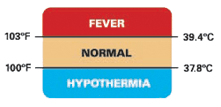Your Pet’s Temperature
By using the Pet-Temp®, you can quickly and accurately monitor your pet’s health. Early identification of changes in your pet’s body temperature will allow for quicker medical treatment resulting in a more favorable outcome. If you suspect your pet is sick, a thermometer should be the first diagnostic tool to measure your pet’s temperature.
Why is monitoring my pet’s temperature important?
The simplest answer is – because companion animals cannot tell you when they are sick. The traditional method of feeling an animal’s nose is not a reliable method of identifying body temperature changes.
When should I measure my pet’s temperature?
- When your pet is sick
- When your pet is recovering from surgery
- When illness is suspected
- For breeding
- When exercising or hiking with your pet
- When your dog is competing or working
- When traveling with your pet
What is normal pet temperature?

As shown in the chart above, the normal ear temperature of resting dogs and cats is typically between 100.0° and 103.0° Fahrenheit (37.8° and 39.4° Celsius). However, normal body temperature can vary depending on the type of animal and their activity level.
Above 103F (39.4C) is a fever, Below 100F (37.8) is hypothermia
What does my pet’s temperature tell me?
In many respects, humans and animals are physiologically and anatomically similar. Both animals and humans suffer from the same types of diseases and both are susceptible to bacteria and viral illnesses. As in humans, the typical body response to an infection is an increase in body temperature. A fever can also be an indication of trauma or something as severe as a brain tumor. A low temperature may be caused by a serious physiological problem such as ingesting a poison or lapsing into a coma.